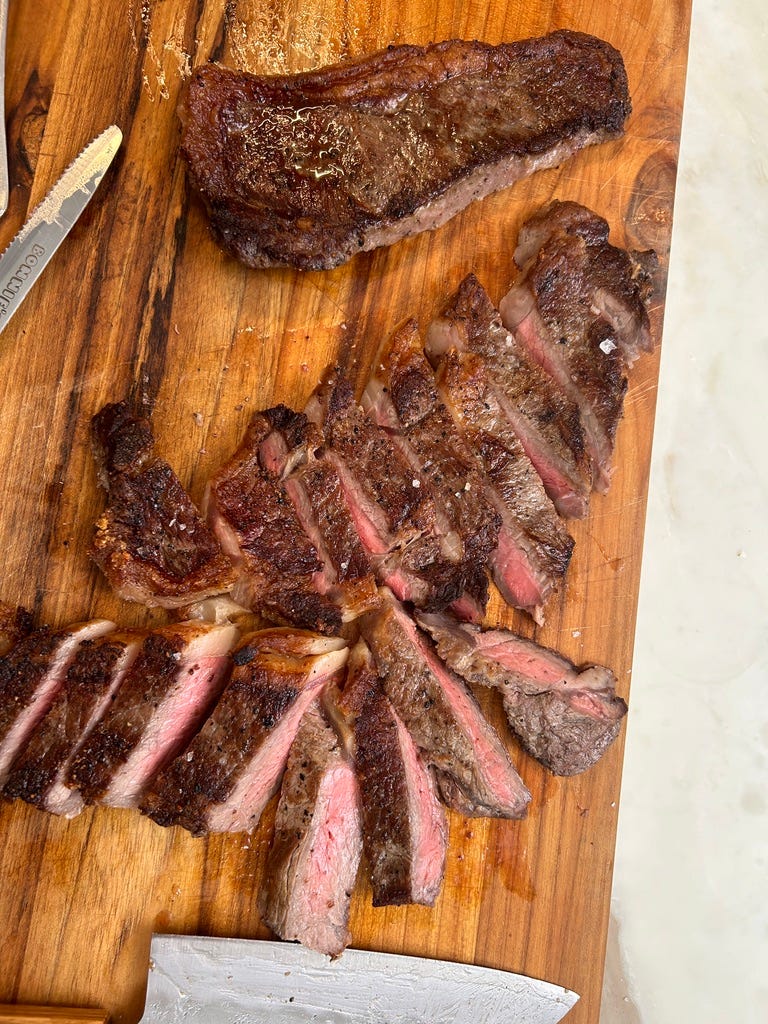New here? Hi! Scroll down for the video link and all the way to the bottom for the recipe!
Hello to all my juicy meat-hunks,
This week’s recipe is a lesson in economy and restraint.
It started with a reminder, learned in the real-life Provincetown kitchen of my friends Roddy Bottum and Joey Holman, that one does not cook 1 1/2-inch thick steaks on the regular.
Roddy and Joey are more famously known as the band Man On Man (their tour starts TODAY, get it!!), but to me they are dear friends and excellent home cooks who also have a direct dial to the CLM Kitchen Hotline. When I visited them in July, our easy steak dinner turned into a teaching moment, in which they made me realize that I had not given enough airtime to cooking “normal” steaks. You know, the ones in the meat section of the supermarket that have been pre-cut about 3/4-inch thick, arranged side-by-side, and wrapped tight in their little styrofoam tanning beds.
Most of my how-to-cook-a-steak content has focused on BigBoys™️, thick-cut New York strips and ribeyes that benefit from the frequent-turning method or big honkers that get finished with butter basting. A thin(ner) steak, as Roddy and Joey elegantly explained, will overcook when done that way, since there isn’t enough time to gradually build up a sear without blasting the interior temperature of the meat. By ignoring this blatant truth, I had not only lost sight of weekday realness, I had let down my friends and constituents.
Today’s recipe and video for typical steak cookery seeks to redeem this glaring gap in content (as always, forgive me for using the C-word).
While frequent turning instructs you to flip the steak from side to side every couple of minutes, a 3/4-inch steak benefits more from a kill-it-on-the-first-side type treatment.
Preheating the pan is absolutely critical; at least 3 minutes over medium-high before adding oil. (Use this time to open windows and doors and disable the fire alarm.
You need more fat in the pan than you think, because the steak will not be luxuriously rendering tallow into the skillet; everything happens too fast.
Even with these precautions, it is very easy to overcook a thin steak, and I encourage you to watch the video to experience a graphic exposé of what I look like when I’ve been humbled and am pretending that “everything is fine!!!!!”
Since “steak and a Caesar” is the most oft-requested boy dinner in my household, I have attempted to justify my existence by creating a new, really fast, completely egg-free and pantry-reliant Caesar dressing for this meal. There’s no gradual whisking or drop-by-drop drizzling involved, and the threat of emulsification breakage is zero. This new Caesar is a literal dump and blend that takes about 30 seconds, and the absence of egg makes for incredibly fridge-stable dressing leftovers.
Ironically, I did overcook the steaks a little bit when filming, which was not the plan. Of course, I wish things were perfect in the demo. But it’s not like I’m not going to release a video where I screw up. I’m trying to be a big enough person to lean into and share my fails; everybody messes up, all the time. Me, especially. In and out of the kitchen, in fact. Even when things are 130°F instead of 122°F, we still eat dinner. And we’ll all be that much wiser the next time requests for steak-and-a-Caesar roll in.
With love from your medium girl in a medium-rare world,
xo
CLM
This week’s recipe is posted below for paid subscribers! Thank you! If you subscribe today, you’ll unlock dozens and dozens of previously-published original recipes along with this one. Your support goes right back into my work developing recipes, food cost, producing videos, and writing about all of it.
Keep reading with a 7-day free trial
Subscribe to Food Processing to keep reading this post and get 7 days of free access to the full post archives.





